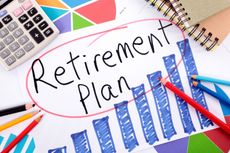New Strategies to Ease Into a Secure Retirement
New strategies to design the lifestyle you want and make sure you have the money to pay for it.

The long-expected "silver tsunami" has finally arrived. The first wave of the nation's more than 77 million baby-boomers turn 66 this year -- the new normal age for full retirement benefits from Social Security -- and that deluge of newly minted seniors will continue at the rate of 10,000 people per day for the next 18 years.
A combination of unpredictable financial markets, the erosion of traditional pension plans, uncertainty about the future of Social Security benefits, and longer life expectancies has created the need for a new model of providing retirement income. "Americans are coming to grips with a striking reality: It is nearly impossible to feel secure about retirement income if most of it is not guaranteed," says Gary Bhojwani, president of Allianz Life Insurance Co. of North America.
But there is a silver lining to the anxieties associated with the silver tsunami. Bhojwani notes that the shock of the recent financial crisis not only contributed greatly to a rapid shift in how Americans view retirement but also provided an unprecedented opportunity to change attitudes and behaviors (see Your Mind and Your Money). And that change is sorely needed. Although nearly 25% of the U.S. population will approach retirement age during the next two decades, many don’t know how to tap their savings effectively once they reach retirement.

Sign up for Kiplinger’s Free E-Newsletters
Profit and prosper with the best of expert advice on investing, taxes, retirement, personal finance and more - straight to your e-mail.
Profit and prosper with the best of expert advice - straight to your e-mail.
A recent survey by Charles Schwab found that one-third of those who say they are just five years away from retirement have not calculated how much income they will need once they stop working. "Many people are confused, scared and frozen when it comes to flipping the switch from saving to withdrawing," says Carrie Schwab-Pomerantz, senior vice-president at Schwab.
A new approach
The traditional three-legged stool of retirement -- pension, Social Security benefits and personal savings -- worked well for the boomers' parents. The boomers blazed a different trail, focusing on maximizing their returns in the stock market to provide for their retirement. With the introduction of 401(k) plans in 1981, stock ownership rose dramatically. By 1989, 32% of Americans were invested in stocks, nearly triple the rate of 30 years earlier. Many boomers savored the exhilarating ride as stocks enjoyed unprecedented growth between 1982 and 1999. Although the market, as measured by Standard & Poor’s 500-stock index, lost 41% between 2000 and 2003 following the dot-com bust, it later recovered and rose to new heights.
But the next blow, the Great Recession, was bigger and far more devastating. Stocks lost 55% of their value between October 2007 and March 2009 -- a loss of about $12 trillion, according to the Center for Retirement Research at Boston College. "People who spent as many as 40 years accumulating wealth saw much of it disappear over 18 months," says Bhojwani. "Many were forced to scale back their expectations or even delay retirement."
Traditional retirement models rely on periodic withdrawals from a balanced portfolio -- usually 4% in the first year of retirement, adjusted for inflation in subsequent years. The conservative withdrawal formula is supposed to account for market fluctuations; but during the severe bear market of 2007 to 2009, some retirees had to reduce their annual withdrawals to preserve their shrinking nest eggs. That’s proof the traditional models don't always work, says Erin Botsford, a financial planner in Frisco, Tex., and author of The Big Retirement Risk (Greenleaf, $21.95). "If boomers continue to follow that established advice, many of them will run out of money," she says.
Botsford has developed her own retirement-income model, which she dubs lifestyle-driven investing. She urges clients to divide all of their expenses into four categories: needs, wants, likes and wishes. Then she recommends relying on "lifestyle investments" -- those that produce income, either now or in the future, and are safe, predictable or guaranteed -- to cover basic needs. "Food and shelter take a higher priority than vacations and luxury cars," she says. "Shouldn't your investment plan reflect this reality?"
If your current savings aren't enough to support your projected retirement lifestyle, you may have to forgo some of your wants, likes or wishes or be willing to save more or work longer to afford them, says Botsford. E*Trade offers a free, easy-to-use calculator to help you envision different types of future retirement living and whether you can afford them based on your current savings, retirement plan contributions and other projected income sources, such as pensions or part-time work.
No perfect investment
Botsford says candidates for predictable income include everything from bonds and CDs to rental income from investment properties or real estate investment trusts (REITs), master limited partnerships, and annuities. Unfortunately, she says, there's no perfect investment product. For example, immediate fixed annuities can turn a lump sum into a guaranteed stream of income for life, but at today’s low interest rates, payouts are meager. Instead, many current and soon-to-be retirees are embracing deferred variable annuities with income guarantees. The potential for 25 years or more of stock-market gains plus protection against losses is undeniably attractive, but these products can be complex, and high fees can easily consume the generous-sounding guarantees (more on these annuities).
Near-record-low interest rates also mean bonds are no longer the slam-dunk income investment that they once were. You should plan to hold individual bonds until maturity to avoid potential loss of principal should rates rise (see Bond Funds That Put Cash in Your Pocket).
As bond interest rates have shrunk, many dividend-paying companies have stepped in to fill the income gap (see Dividend-Growth Stock Picks). And with many target-date retirement funds reaching their target, fund managers are coming up with ways of converting those assets into income (see Know Your Target-Date Fund's Retirement Strategy). "Lifestyle-driven investing is about ensuring that you do not run out of money before you run out of time," says Botsford.
Ron and Jo Foster of Greensboro, Ga., credit Botsford's guidance with allowing them to live comfortably in retirement and to sleep well at night during recent periods of stock-market volatility. When Ron, 63, retired early from a corporate career in 2004, the majority of the Fosters’ net worth was in company stock. Botsford set up a schedule to systematically sell half of that stock over a five-year period, using the money to fund income-producing investments, such as annuities and REITs, to cover their day-to-day living expenses. The Fosters invested some assets on their own, and Ron admits that they suffered substantial losses in the 2007–09 bear market. But because of the built-in income protection of their other investments, their lifestyle didn't suffer. They have enough money to travel and savor the resort-style activities in their lakefront golf course community. "It's a little slice of heaven," says Ron.
Working longer
The Great Recession deflated countless retirement dreams. Many older workers now find themselves in the position of Herk Vanden Bosch of Zeeland, Mich., who originally hoped to retire in his mid fifties. Now the 62-year-old head of Zeeland Lumber says he'll work a few more years to rebuild his retirement balance, which remained essentially flat during the past, lost decade.
Not only are more older workers expecting to work longer; many now say they never expect to retire, according to the Employee Benefit Research Institute. In 2006, just before the recession, 11% of workers 50 and older said they expected to retire at 70. But by 2010, after the recession had officially ended, the number of those expecting to work until 70 had increased to 15%.
Vanden Bosch plans to keep contributing the maximum amount to his 401(k) as long as he can. In 2012, workers can contribute up to $17,000 to a 401(k) or similar employer-based retirement plan, and those 50 and older can kick in an extra $5,500, for a grand total of $22,500 this year.
Vanden Bosch is also taking more control over his investments. When he turned 59½, he took an "in-service" distribution from his 401(k) plan and rolled the balance into an IRA to avoid paying taxes on that money. He then diversified his assets beyond the mutual fund choices that were available in his company plan to include more income-producing investments, such as dividend-paying stocks, preferred stocks and bonds.
Vanden Bosch and his wife, Linda, aren't waiting until he fully retires to enjoy themselves. They love active vacations, such as paddling down the Colorado River, and hope to set foot on every continent while they are still young and healthy enough to enjoy it.
A dry run
Without realizing it, the Vanden Bosches have joined one of the latest trends in retirement planning: practice retirement. Christine Fahlund, senior financial planner for T. Rowe Price, urges older workers to start to "play" in their sixties while they continue to work. That allows them to test some of their retirement dreams. "Maybe you'll discover that RVing isn't as fun as it sounded, and being close to family is important now," says Fahlund (see Rethinking Retirement).
Working just a few more years can stretch your retirement savings -- even if you stop contributing to your 401(k) plan. (However, if your employer offers matching contributions, you should kick in enough to your retirement plan to capture the match.) You can use the money that you would usually contribute to your retirement accounts to explore travel or other interests before you fully retire. Or you could divert that cash to pay down debt or pay off the mortgage.
Even if you stop contributing to your nest egg, not tapping it allows your retirement savings to continue to grow. Working longer also enables you to keep health insurance and access to tax-advantaged flexible spending accounts. And if you wait until you stop working to collect Social Security benefits, you'll lock in a larger benefit and create a bigger base for future cost-of-living adjustments. "The transition period is not just a time to let your nest egg grow," says Fahlund. "It's an opportunity to start enjoying the retirement lifestyle that will be most fulfilling to you and to try it on for size."
Use the Practice Retirement tools and calculator. For help with the transition from saving to withdrawing money, check out Schwab's free Retirement Income Fundamentals action guide.

-
 It’s Tax Day: Is the Post Office Open Late?
It’s Tax Day: Is the Post Office Open Late?Tax Filing Tax Day is here and some people need to mail their federal income tax returns.
By Kelley R. Taylor Published
-
 Need to Build an Emergency Fund? Seven Steps to Get There
Need to Build an Emergency Fund? Seven Steps to Get ThereHaving a safety net can mean peace of mind on top of being able to maintain your lifestyle if a financial emergency strikes.
By Justin Stivers, Esq. Published
-
 403(b) Contribution Limits for 2024
403(b) Contribution Limits for 2024retirement plans Teachers and nonprofit workers can contribute more to a 403(b) retirement plan in 2024 than they could in 2023.
By Jackie Stewart Published
-
 SEP IRA Contribution Limits for 2024
SEP IRA Contribution Limits for 2024SEP IRA A good option for small business owners, SEP IRAs allow individual annual contributions of as much as $69,000 a year.
By Jackie Stewart Published
-
 Roth IRA Contribution Limits for 2024
Roth IRA Contribution Limits for 2024Roth IRAs Roth IRA contribution limits have gone up for 2024. Here's what you need to know.
By Jackie Stewart Published
-
 SIMPLE IRA Contribution Limits for 2024
SIMPLE IRA Contribution Limits for 2024simple IRA The maximum amount workers at small businesses can contribute to a SIMPLE IRA increased by $500 for 2024.
By Jackie Stewart Published
-
 457 Contribution Limits for 2024
457 Contribution Limits for 2024retirement plans State and local government workers can contribute more to their 457 plans in 2024 than in 2023.
By Jackie Stewart Published
-
 Roth 401(k) Contribution Limits for 2024
Roth 401(k) Contribution Limits for 2024retirement plans The Roth 401(k) contribution limit for 2024 is increasing, and workers who are 50 and older can save even more.
By Jackie Stewart Published
-
 Is a Medicare Advantage Plan Right for You?
Is a Medicare Advantage Plan Right for You?Medicare Advantage plans can provide additional benefits beneficiaries can't get through original Medicare for no or a low monthly premium. But there are downsides to this insurance too.
By Jackie Stewart Published
-
 What You Must Know About the Different Parts of Medicare
What You Must Know About the Different Parts of MedicareMedicare Medicare can be complicated but we've got you covered. Here is a quick guide to the different benefits provided through each part.
By Jackie Stewart Last updated